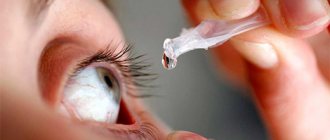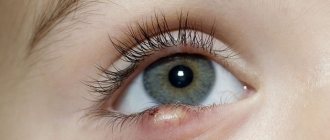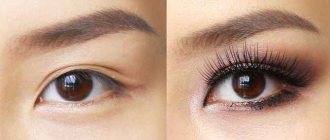Any problems in a person’s health leave their marks not only inside the body, but also leave their mark on his body and face.
Impaired shock absorption of the membrane separator that holds the periorbital tissue in the orbit causes swelling under the eyes. As a result of various provoking causes, it is stretched and bulges, resembling a hernial sac.
Fatty deposits of tissue adjacent to it grow and leave the orbital area, forming bags. An additional condition for the formation of puffiness is the natural qualities of fiber - it promotes the accumulation of fluid in the tissues.
The appearance of puffiness under the eyes in older people is not surprising. With age, the process of age-related withering of the skin begins with a loss of its elasticity and additional fat deposits that contribute to the formation of puffiness.
The layer of adipose tissue serves, in a way, to protect the eye from the orbital processes of the zygomatic bone. When excess moisture forms, fatty tissue retains it, thereby promoting puffy formations under the eyes. Tension of senile skin allows blood vessels to show through, creating dark circles around the eye sockets.
Similar pathologies occur in most young people who do not pay special attention to them. Considering this manifestation to be a consequence of over-drinking or salty food eaten at night. But the etiology of the disease may be completely different.
Causes of puffiness under one eye
Swelling under the eyes can be one of the manifestations of a general somatic pathology, so you need to see a doctor and undergo a basic examination. One of the reasons for the appearance of puffiness under the eye can be an allergic reaction of the body to a drug, household dust, or any food product. The skin around the organ of vision is very delicate and instantly reacts to any allergen by causing swelling. In addition to swelling, itching also occurs. Symptoms disappear immediately after exposure to the allergen ceases.
Another reason is injury to the area under the eye or another part of the face and head, from where swelling can spread under the eyeball. If the forehead or bridge of the nose is damaged, swelling often spreads to the eyes.
The development of an infectious disease of the lower eyelid may occur. For example, this includes conjunctivitis, blepharitis, barley - inflammatory processes that are accompanied by a similar symptom. The features of such diseases are: pronounced hyperemia of the eyelid, pain when touched.
In the summer, an insect (wasp, bee, mosquito, hornet, midge, etc.) can sting under the eye. The bite causes not only swelling, but also itching, redness of the skin, and pain.
This situation should not be overlooked, because a bite on the eyelid is a fairly serious problem. The skin in this area can stretch greatly, and swelling can reach a significant size.
Swelling of one eye occurs when an inflammatory process develops in the facial nerve. Characteristic symptoms are pain radiating to the spine and head. Also, the cause may lie in a hernia of the spine in the cervical region. In this case, a person is worried not only about swelling under the eye, but also about neck pain, poor coordination of movements, and muscle weakness.
Otolaryngological diseases, such as sinusitis, can occur with discharge from the sinuses, pain in the eyes and forehead, as well as swelling localized at the site of the sinus projection. Some dental pathologies, for example, purulent and inflammatory processes, often develop with this symptom.
With an unhealthy lifestyle, constant lack of sleep, excessive consumption of spicy and salty foods, alcoholic drinks, severe eye strain, swelling on one side occurs in the morning, and more often on the side on which the person slept.
If you take the wrong position while sleeping, you are likely to wake up in the morning with swelling under one eye. This can be explained by the difficulty of venous outflow of blood in the vessels that are localized around the organ of vision.
Causes of nervous tics
The reasons why the lower eyelid twitches are as follows:
- Nervous fatigue, which occurs due to frequent stress, depression, lack of sleep or anxiety. Such symptoms occur in pregnant or lactating women, in those living in big cities, whose body is trying to adjust to a new rhythm; they experience frequent attacks of irritability and emotional stress. If you don't get rid of this in time, a nervous tic appears.
Important! The problem of lower eyelid twitching can affect both adults and children. The latter may begin to stutter.
- Eye fatigue, i.e. heavy load on the organs of vision. This is caused by prolonged work at the computer, watching TV, reading in low light, etc. This is especially true for people with vision problems (myopia, farsightedness), as well as those wearing contact lenses or glasses.
- Overexcitation of the nervous system, in which the speed of impulse transmission becomes faster and their innervation becomes disordered. This leads to a nervous tic. The causes of such phenomena are: frequent emotional stress, abuse of coffee, alcohol, etc.
- Vitamin deficiency, namely a lack of vitamin B. Therefore, you need to consume a sufficient amount of magnesium, as well as eat a healthy and balanced diet.
- Chronic and infectious diseases. This includes allergies (which are quite rare), tonsillitis, damage to the blood vessels of the brain, etc. In this case, treatment consists of eradicating the cause of the disease, and only then the nervous tic.
Important! If your lower eyelid twitches after a head injury, it may be a concussion.
Sometimes the cause of eyelid twitching is lack of sleep and an unhealthy lifestyle. Therefore, to relieve such symptoms, you should spend more time in the fresh air, eat more vegetables and fruits, and strengthen your immune system.
In children, hereditary twitching of the left or right eyelid is possible, which manifests itself in infancy.
Possible reasons
Unilateral swelling of the lower eyelid in combination with pain can occur for various reasons.
Inflammation of the eyelid tissue (blepharitis)
The disease is manifested by itching and discomfort of varying severity, redness of the edge of the eyelid, swelling, and the presence of discharge. The patient complains of lacrimation, a feeling of a foreign object in the eye.
Swelling of the lower eyelid caused by blepharitis (inflammation of the lower eyelid)
Stye, chalazion
Stye is an inflammation of the hair follicle in the lower eyelid. Internal barley is an inflammatory process provoked by streptococcus or staphylococcus that affects the meibomian gland.
The conjunctiva turns red, and 2-3 days after the onset of the disease, accumulations of pus become visible on the inside of the lower eyelid.
Internal stye on the lower eyelid
If treatment is insufficiently effective or if it is not started in a timely manner, internal barley can cause a complication in the form of a chalazion. This is a chronic inflammatory process of a proliferative nature that forms around the meibomian gland. It is easy to recognize by the appearance in the thickness of the eyelid of a painless nodule ranging in size from a few millimeters to a pea. The nodule has a dense consistency, the skin over it is not changed, and the conjunctiva in this area is hyperemic.
Trauma of the Century
During a physical examination, the following is found:
- swelling and subcutaneous hemorrhages in the lower eyelid,
- narrowing of the palpebral fissure,
- exophthalmos or enophthalmos,
- possibly the presence of abrasions and wounds.
In case of a fracture of the orbital walls, emphysema is determined by palpation.
Dacryocystitis
Dacryocystitis is an inflammation of the lacrimal sac, which can occur in both acute and chronic forms.
Acute dacryocystitis often occurs against the background of a chronic inflammatory process of the eyeball or its appendages. The pathology always manifests itself as lacrimation, redness in the lower eyelid, and severe pain localized in the inner corner of the eye.
Examination reveals swelling and hyperemia in the area of the lacrimal sac, palpation of the lower eyelid is painful. From the onset of the disease, a narrowing of the palpebral fissure is observed.
Dacryocystitis – inflammation of the lacrimal sac
Even with slight pressure on the area of the lacrimal sac, pus is discharged from the lacrimal openings. The general condition suffers due to intoxication, body hyperthermia, weakness, and headaches occur.
After several days, the infiltrate in the lower eyelid area softens, and fluctuation is detected by touch. An abscess is formed, which in some cases can open on its own.
Abscess of the lower eyelid
In a newborn, the cause of dacryocystitis and subsequent suppuration, as a rule, is obstruction of the nasolacrimal canal as a result of the presence of unresolved embryonic tissue in it.
Phlegmon
The disease occurs as a result of infection due to injury or infection from surrounding tissues. The cause of phlegmon of the eyelid can be an infectious-inflammatory process localized in the sinuses and upper respiratory tract. Infection may occur during sepsis.
Cellulitis may be the result of untimely initiation of treatment for stye or blepharitis.
Erysipelas
Erysipelas of the eyelids is a pathology caused by hemolytic streptococcus or staphylococcus (less commonly). The prevalence of the disease is 3 cases per 1000 people.
Erysipelas of the eyelid
It has been established that manifestations of pathology occur against the background of a decrease in the function of humoral and cellular immunity. Experts call the main risk factors for the disease:
- 1. Metabolic disorders, in particular, carbohydrate imbalance: diabetes mellitus, insufficient glucose tolerance.
- 2. Trophic disorders in the skin of the eyelids. Predisposing factors are scars accompanied by areas of local ischemia.
- 3. Mechanical damage to the skin. Areas with impaired integrity of the epidermis are entry points for infection.
- 4. Bad habits (smoking, drinking alcohol, drugs).
- 5. Mycotic infection.
At the same time as the lower eyelid, the upper eyelid may also be affected.
Local manifestations of the symptoms of erysipelas are preceded by a general intoxication syndrome.
Insect bites
Both local and general reactions to insect bites are caused by the following factors:
- 1. The very fact of violation of the integrity of the skin of the eyelid.
- 2. Allergic reactions to components of insect saliva.
- 3. Possibility of infection of the wound after a bite.
Local manifestations of allergies to cosmetics
This disorder differs from a generalized allergy to cosmetics by a focal lesion: signs of an allergy develop only in a certain area - at the site of application of the allergenic product. The reaction may take the form of urticaria (formation of blisters against the background of congested skin) or diffuse swelling.
Century carcinoma
A malignant tumor is characterized by rapid development.
Wisdom teeth
Our ancestors compensated for their lack of ability to properly digest plant foods by chewing them thoroughly. But with the advent of agriculture, the human diet changed, and as a result, the jaws began to move forward less, leaving less space for wisdom teeth. Because of this, in some people they do not fully grow in because they are blocked by other teeth and must be removed.
Diagnosis of the cause of edema
There are many creams to eliminate puffiness under the eyes, but it is advisable to choose the brand of cosmetics that you usually use. As is already clear, the reasons why swelling under one eye may occur are varied. That is why it is important to determine the true source of the symptom in order to carry out the most effective treatment and prevent the development of dangerous consequences.
If the swelling was preceded by an insect bite, in its place you can find a point - a bite mark. A symptom that occurs after an injury is also considered predictable and does not cause difficulties in diagnosis. If such a manifestation on one side occurs for no apparent reason and does not disappear for a long time, you should sound the alarm and consult a doctor.
The specialist will first examine the area with swelling, if necessary, and prescribe laboratory and instrumental studies. Based on an external examination, the doctor determines the characteristics of the affected area: the ability to fully open the eye, the color of the swelling, the presence of pain, itching and burning. If an inflammatory process develops, the characteristic symptoms will be: swelling, pain, hyperemia, discharge.
Swelling that occurs after injury occurs with pain, hematoma, and sometimes a wound. An allergic reaction is accompanied by lacrimation and the release of a characteristic fluid. The swelling in this case is pale, painless, but itchy.
Laboratory examinations may require allergy tests, biomicroscopy (to identify an inflammatory process in the eye), determination of the level of blood clotting, and biochemical analysis (to determine the level of kidney function). Possible instrumental studies are ultrasound and electrocardiogram.
Diseases
The lower eyelid can be pulled down; this property is ensured by the work of the mechanism of the eye muscle, although it is poorly developed. However, the state of balance may be disturbed due to the development of pathological changes that can affect the layers of the inferior palpebral groove.
Symptoms of the lesion
Manifestations of diseases depend on the type of disorder, but external symptoms are clearly visible, and on both eyelids:
- the state of swelling is not always associated with an ophthalmological diagnosis (for example, kidney disease);
- sensations of itching and pain along with reddened skin are clear signs of an inflammatory process;
- the appearance of local compaction of a thin strip of tissue protecting the eye requires urgent identification of the cause;
- An unusual appearance of the skin furrow at the base of the eye often indicates the onset of a nerve disorder.
Pathological changes affecting the lower eyelid may be accompanied by a feverish state, eyelid non-closure syndrome, which threatens drying out of the conjunctiva.
The main reasons for the development of diseases of the eye protective barrier include:
- pathological activity of skin mites due to weakened immunity;
- various types of allergic reactions (seasonal, medicinal, food);
- infection of the body by viruses and microbes, the effects of chemical reagents;
- disorders of the cardiovascular and endocrine nature, hormonal imbalance.
If there is the slightest discrepancy in the external parameters of the lower eyelid, you should immediately seek the help of an ophthalmologist. Only a specialist can determine the type of eye disease that is causing the dangerous symptoms. Among the most common pathologies of the palpebral sulcus are the following conditions.
Everted eyelid
The inverted position of the fold leads to a violation of the physiological protection of the mucous membrane of the organ. The anomaly may occur due to age-related weakening of the facial muscles, injury or burn of the eyeball, or the appearance of a neoplasm. The progress of the destructive process leads to exposure of the mucosa, causing drying of the conjunctiva along with the corneal layer.
In addition, the palpebral fissure does not close completely, which is also observed when the lower eyelid turns up. In both cases, the patient suffers from constant lacrimation, but with inversion, the cause of lacrimation is irritation of the mucous membranes by the eyelashes directed inward.
The danger of meibomite
The lower eyelid is where the cartilaginous glands are located. The inflammatory process can affect the meibomian glands due to clogged sebaceous ducts. The main cause of the pathology is the colonization of tissue structures by pyogenic microbes, most often staphylococci.
The course of meibomitis can be acute, then the process is accompanied by vivid symptoms of pain, signs of redness and swelling. The chronic form of ophthalmia is recognized by thickening of the plate of the lower eyelid.
A characteristic symptom of the chronic course of the disease is the formation of a cystic formation in the thickness of the gland; in medicine it is called a chalazion. Externally, the cyst resembles a traditional stye on the upper eyelid, but before choosing a treatment method, the doctor must determine the nature of the structure of the chalazion.
Diseases of internal organs and systems
Sometimes it swells under the right eye as a result of problems with lymphatic drainage
. Some people have increased venous pressure due to heart failure or pericardial problems. When protein metabolism is disrupted, swelling occurs not only under one eye. Swelling worries throughout the body.
If this eye is swollen, the reasons must be looked for in completely, it would seem, unexpected places. For example, you have a herniated disc or a pinched nerve on the right. If the pinching occurs on the left side, then there will be swelling under the left eye.
If this eye systematically swells, the reasons should be sought in alcohol abuse, overeating salty foods, spending a long time in front of a computer or with a phone in hand and lying on the right side, sleeping too deeply, also on the right side. In this case, as an emergency morning measure, you can try applying (preferably a bag of chamomile tea), just a chamomile decoction applied to the area of the swollen eyelid. Of course, this will not completely remove the puffiness, but it can slightly smooth out the difference between the two eyelids.
When there are more serious causes, concomitant symptoms, such as with conjunctivitis, it is strongly recommended to be treated by a doctor.
Just in case, it’s worth undergoing a comprehensive diagnosis and clarifying whether there are probably problems with the body’s systems. It is better to exclude diseases of internal organs or identify them in the early stages, rather than start the process by trying unsuccessfully to cope with their manifestations using folk methods. By the way, in case of problems with internal organs, you should not be angry at the appearance of swelling, but “thank” the swelling of the eyelid of the right eye, because it signals that you need to pay attention to your health.
In the autumn or spring season of constant colds, the question of why the right or left eye swells is quite common. The so-called cold swelling
may be accompanied by difficulty breathing through one nostril and red eyes. If there is nasal congestion on the right side, then it is not surprising that the right eyelid is swollen. And vice versa.
For right-sided sinusitis, sinusitis
the right eye is affected. It can also be left-sided or even bilateral - then the problem affects both eyes.
Sometimes with a common runny nose
in the morning the right eye swells, even if the nose on the left side is stuffy. This is due to the fact that the patient suffers from a lack of nasal breathing, restless sleep due to discomfort, increased temperature, then the general unhealthy and swollen appearance of the face with swelling under this eye is also caused by the fact that most of the night you tried to lie on one side or another , because one of the nostrils was clogged.
In case of cold swelling, the first thing to do is treat these diseases. As the body recovers its strength, the appearance of the face will also improve.
We did not write in more detail about stress, insufficient sleep, and poor diet, since these are understandable and obvious reasons. But sometimes you just need to normalize your nightly rest routine
– and morning swelling, including those that are disturbing only on one side, will go away without special measures: lotions, medications and taking specific medications.
Sometimes children, even those who are absolutely healthy at first glance, have swollen eyelids. Panic on the part of parents in such cases is usually not observed: well, you never know, a mosquito bit you right in the eye or drank too much water before bed! If this is the reason, then the swelling under the child’s eye will go away quickly, but there are different types of swelling, and some of them may indicate serious problems with the baby’s health.
Goose pimples
Skin bumps appear when tiny muscles at the base of the hair contract in an emergency or due to irritants such as a gust of cold wind. In animals with fur, this helps trap air between the hairs, which creates a layer of insulation and prevents hypothermia.
People experience goose bumps from screeching, metal scraping, music, feelings or strong emotions, watching horror movies, or experiencing exciting events such as winning a sporting event. Some are able to deliberately cause goose bumps in themselves.
Treatment with folk remedies
For puffiness under the eyes, they use traditional medicine, which have proven themselves well. You can get rid of puffiness under the eye using potatoes:
- take 1 small potato, peel it;
- wash thoroughly;
- cut into circles;
- Apply to the affected area and leave for 20 minutes.
You can grate the potatoes, add parsley, wrap them in gauze and apply a compress to the swelling, leaving for 30 minutes. Boiled potatoes in their skins give a good effect.
It is possible to use medicinal plants, such as chamomile. An infusion is prepared from it: 2 tbsp. pour 200 ml of boiling water over the raw materials and leave to infuse for 15 minutes. After the infusion has cooled, soak a cotton pad in it and apply it to the affected area. They are changed as the infusion cools.
Rose flowers will also help: pour a handful of petals into 200 ml of hot water and leave to steep for 30 minutes. Use the resulting product as a compress on the problem area 2 times a day.
You can prepare a mask that removes puffiness from the eye. For example, parsley is often used: chop the greens, take 1 tsp, mix with sour cream in a volume of 2 tbsp. The mask is applied for 20 minutes, then washed off with warm water. Carry out the procedure daily. You can also use cottage cheese, which is placed in a piece of gauze and applied as a compress to the swelling for 10 minutes.
Treatment
Eye lipofilling
To establish the exact cause and get the correct and detailed answer to the question of what to do if the lower eyelid is swollen in one eye and hurts, you need to visit an ophthalmologist. He may refer the patient to a GP for a medical examination. Blood and urine tests are required, and scrapings are taken to rule out a bacterial infection.
Depending on the identified cause, in agreement with the ophthalmologist, treatment can be prescribed by an endocrinologist. When determining an eye disease, complex therapy is carried out by an ophthalmologist. It includes the use of drops, ointments, lotions, drugs in tablet form or antibiotics for intramuscular injection. Among the ointments, it is worth noting the effectiveness of Hydrocortisone, Prednisolone and Celestoderm.
With sinusitis, sometimes swelling of the lower eyelid disappears after surgery is performed to eliminate the underlying disease.
We must remember that there are actions that are prohibited when there is swelling of the eyelid. Warm compresses and applying any force to the inflamed area are not recommended. Also, until complete recovery, you must stop using cosmetics.
Home treatment
To solve the problem, there are traditional medicines that help in the healing process. Among them it is worth highlighting:
- Washing with tea. A solution of boric acid is effective for the same procedure. After washing the eyes, lubricate with Hydrocortisone ointment.
- Rubbing the swelling with ice every day can help a lot. It can be made from parsley decoction.
- Lotions made from grated potatoes, used raw, have proven themselves well.
- Compresses made from cucumber or boiled potatoes.
Do not self-medicate. See your doctor.
To relieve swelling if there is no ice, you can apply a spoon. There are positive reviews about using soda to wash the eyes.
We must remember that a healthy lifestyle and cleanliness help to avoid many diseases, including in the eye area.
Sep 28, 2017
Ready-made medications for swelling under the eye
Considering the main cause of the swelling, you can use ready-made medications. The most convenient forms of drug release are eye drops and eye ointment. Such drugs have an impact specifically on the focus of the inflammatory process, helping to quickly get rid of the symptom. So, to treat swelling under one eye, the doctor may prescribe:
- Antibacterial drug (to eliminate the bacterial inflammatory process, for example Ofloxacin in the form of an ointment).
- Steroid drug (to eliminate seasonal allergies - Prednisolone, Hydrocortisone, Dexamethasone).
- Antihistamine or desensitizing drug (to reduce allergic swelling, for example: Claritin, Zyrtec, Suprastin).
- Antiseptic drug (boric acid for disinfecting the affected area).
- Diuretic drug (to remove excess fluid from the body, for example: Furosemide, Torasemide).
- Sulfacyl sodium drops 30% (to eliminate infection, in combination with intramuscular administration of an antibacterial drug).
Symptoms, signs and diagnosis
The main symptom is swelling of the lower eyelid or around the eyes. Depending on the cause of the tumor, unilateral (with barley, conjunctivitis) and bilateral (kidney disease, allergies) swelling is distinguished. In addition, there are many symptoms that are inherent to the disease that causes swelling in the eye area. These symptoms include:
- changes in urine;
- pain when urinating;
- high body temperature (glomerulonephritis);
- weakness;
- decrease in blood pressure;
- drowsiness (hypothyroidism);
- catarrhal phenomena with hay fever.
To understand how to remove swelling under the eyes, it is necessary to correctly diagnose the underlying disease. For this purpose, the patient is carefully questioned about the remaining symptoms of the disease, a general urine test is prescribed, and an analysis is performed to determine thyroid hormones. In some cases, the cause of the swelling under the eyes is not revealed during examination. This occurs when there is no disease, but swelling appears, for example, with increased fluid intake, constant lack of sleep, or pregnancy.
Jacobson organ
The vomeronasal organ was first discovered by the Danish anatomist Ludwig Levin Jacobson in 1811. It is located at the base of the nasal cavity just above the palate. The organ contains receptors that help detect certain types of non-volatile or liquid, organic compounds that may come from prey, predators or potential mates.
Unlike the olfactory bulb, which sends signals directly to the olfactory cortex, the Jacobson's organ sends signals to the hypothalamus, which is responsible for regulating hormone production and body temperature.
Jacobson's organ is present in all snakes and lizards, as well as in many mammals.
In humans, it develops in the embryo, but after that it regresses and the nerve connections disappear. The cavities persist in some adults, but without a functional nervous system the organ simply does not function.
Express tips for relieving puffiness
If the swelling increases in size, or additional complaints arise, contact a specialist. You can quickly eliminate swelling under the eye using cold lotions. Any cold product (for example, from the refrigerator) or a regular tablespoon will work perfectly. Cold causes vasoconstriction, thereby helping to reduce swelling and redness on the skin. The only contraindication for the compress is an ongoing inflammatory process (for example, barley).
You can eliminate morning swelling with a massage using your ring fingers. It is also good to lightly tap the area with swelling, as well as rubbing and circular movements with your fingers. It is recommended to massage with eye cream.
An excellent remedy is a compress made from pre-chilled tea bags. The package is applied to the affected area and left for 20 minutes. A lotion made from fresh cucumber will also be effective.
Reasons for appearance
A tumor under the eye, the cause of which has not been established, requires a thorough examination of the entire body in order to exclude some serious diseases of the internal organs. Possible causes of the tumor:
- Kidney disease – Most often, swelling under the eyes is a symptom of glomerulonephritis, a serious disease that can lead to kidney failure. In this case, swelling under the eye refers to swelling of the eyes on both sides, which usually appears in the morning hours after sleep.
- Thyroid disease - Puffiness from an insufficient thyroid gland (hypothyroidism) usually appears as swelling around the eye, but can involve the area under the eyelids or the entire face. Such swelling is characterized by softness on palpation, as it is filled with mucus from the inside.
- Allergic reactions - most often the eyes become swollen due to hay fever, that is, seasonal allergies to flowering plants. Characteristic for such a tumor is seasonality and connection with an allergen, as well as catarrhal syndrome (runny nose, difficulty breathing).
- Infections of the lining of the eye (conjunctivitis) or sebaceous gland (styre) - these conditions are easily diagnosed as they progress, but may appear as a tumor under the eye at the very beginning of the disease.
Third eyelid
It also has another name - the semilunar fold, which is applicable only to humans. Some people don't even suspect its existence. It is located in the inner corner where the upper and lower eyelids meet. Outwardly, it resembles a thickening of the mucous membrane. This is a rudiment that a person inherited from his ancestors and was modified in the process of evolution from the nictitating membrane. Today, the nictitating membrane exists in a number of birds, fish and animals.
By the way, the rudiments of the nictitating membrane are formed even in the baby in the womb, but during pregnancy and as the fetus develops, this part atrophies. Among representatives of the Negroid race, this rudiment is slightly more developed than among Asians and Europeans.
The fold is capable of synthesizing a mucous secretion that helps moisturize the eyes and prevent foreign objects from entering. But in general, experts talk about the low functionality of the third eyelid, considering it an almost useless organ.
Prevention
To prevent puffiness that may occur under one eye, you need to follow some recommendations:
- adhere to a daily routine, spend at least 8 hours sleeping;
- do not abuse alcoholic beverages and salty foods;
- do not spend a lot of time at the computer and reading, give your vision rest;
- maintain personal eye hygiene.
In any case, only a doctor can determine what treatment a particular person needs. If you suspect the development of an inflammatory process, you should not self-medicate, but rather contact a competent specialist.
In the video below, the doctor talks about the causes of bags and swelling under the eyes, as well as ways to eliminate them:
Preventive measures for swelling of the lower eyelid
It doesn’t matter whether we are talking about swelling of the lower or upper eyelid, there are several really working techniques that will prevent the presence of this disease. Of course, we are not talking about cases where the cause of edema lies in other diseases, the solution of which should be addressed first. You need to lead a healthy lifestyle, avoid alcohol and excessive consumption of salty and spicy foods, monitor your water balance (drink at least two liters a day), and do eye exercises on a regular basis. Especially if you spend a lot of time at the computer or with gadgets. Before touching your eyes, you must wash your hands thoroughly, do not use other people's cosmetics, follow the rules of visual hygiene and regularly visit the ophthalmologist's office.
What is the difficulty in diagnosing blepharitis of the upper eyelid?
Blepharitis in the upper eyelid is more difficult to diagnose than in the lower eyelid. The difficulty in recognizing this eye disease lies in the likelihood of relapse. Some patients are confident that if they were previously diagnosed with blepharitis, then there is nothing to worry about. Therefore, many of them turn to the ophthalmologist too late and begin treatment.
Treatment for blepharitis done at home usually does not produce positive results. This is only possible in cases where treatment was started immediately when the first signs of the disease appeared. In all other cases, postponing a visit to the ophthalmologist delays treatment for blepharitis and contributes to the spread of infection throughout the body.
In extreme cases, serious complications can occur. In such situations, the patient will have to visit not only an ophthalmologist, but also a dermatologist or allergist. In later stages of the disease, cell scrapings of the eyelash epithelium may be necessary. Inflammation of the upper eyelid requires an integrated approach to treatment. It is recommended to “resort” to three leading directions: local, etiological and restorative therapy.











